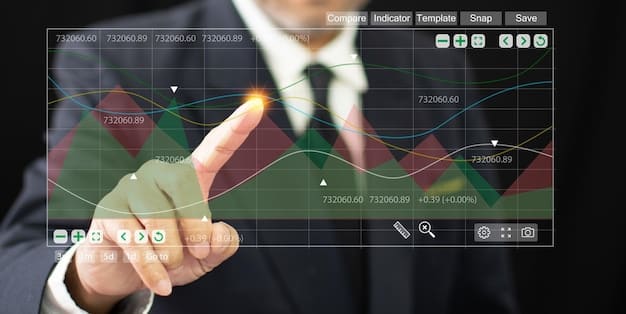Fed Signals 0.5% Rate Hike: Businesses Brace for January Impact

The Federal Reserve’s signal of a potential 0.5% interest rate hike in January could significantly impact businesses by increasing borrowing costs, tightening credit conditions, and potentially dampening consumer demand, requiring strategic financial re-evaluation.
In a pivotal development, the Federal Reserve has signaled a potential intent to increase interest rates by 0.5% as early as January, a move with significant ramifications across the economic landscape. This anticipated adjustment is not merely a number change on a balance sheet; it represents a critical inflection point for businesses large and small. Understanding the mechanisms behind such a decision, and more importantly, its multifaceted implications for operational costs, investment strategies, and consumer behavior, becomes paramount for companies navigating an already complex economic environment. The impending shift necessitates a proactive approach to financial planning and risk management, as businesses prepare to absorb potential increases in their cost of capital and adjust projections amidst evolving market conditions.
Understanding the Federal Reserve’s Stance and Economic Context
The Federal Reserve, often dubbed “the Fed,” operates as the central bank of the United States, tasked with maintaining maximum employment, stable prices, and moderate long-term interest rates. Its decisions on monetary policy profoundly influence the nation’s economic trajectory. The recent signal of a potential 0.5% interest rate hike in January is not an isolated event but rather a response to a complex interplay of economic indicators and global pressures. For businesses, comprehending the rationale behind such a significant move is the first step towards formulating effective coping strategies.
The Fed’s primary tool for implementing monetary policy is the federal funds rate, a target rate for interbank lending. Adjustments to this rate cascade through the financial system, affecting everything from consumer loans and mortgage rates to corporate borrowing costs. A 0.5% increase, though seemingly incremental, represents a substantial tightening of monetary conditions, indicating the Fed’s concern over persistent inflationary pressures. This could be a reflection of strong labor markets, continued consumer spending, or even supply chain disruptions that maintain upward pressure on prices.
The Mandate and Drivers of Monetary Policy
The Federal Reserve’s dual mandate necessitates a delicate balancing act. On one hand, it aims to foster conditions that lead to the lowest possible unemployment rate; on the other, it strives to keep inflation in check. When inflation runs hot, as it has in recent periods, the Fed typically responds by raising interest rates to cool down the economy. This makes borrowing more expensive, which can reduce consumer demand and business investment, thereby alleviating price pressures. However, critics often point to the risk of “overtightening,” where aggressive rate hikes could trigger a recession or significantly slow economic growth.
- Inflationary Pressures: Sustained periods of high inflation often compel the Fed to act decisively. Factors like elevated energy prices, supply chain bottlenecks, and robust wage growth can contribute to this scenario.
- Labor Market Strength: A tight labor market, characterized by low unemployment and rising wages, can signal a robust economy but also contribute to inflationary pressures, prompting the Fed to consider rate hikes.
- Global Economic Conditions: International events, such as geopolitical tensions, commodity price volatility, and economic performance in major trading partners, can also influence the Fed’s decisions.
Historical Precedents and Market Expectations
Examining past cycles of interest rate hikes provides valuable context. Historically, periods of rising rates have presented challenges but also opportunities for businesses. Companies that adapted swiftly by optimizing their capital structures, trimming unnecessary expenses, and focusing on efficiency often weathered these storms effectively. The current market expectation largely hinges on the Fed’s commitment to bring inflation back to its target range, even if it entails some degree of economic slowdown.
The decision to signal a specific increase like 0.5% in January is likely a finely calibrated communication strategy. It aims to prepare markets, allowing businesses and investors to adjust their strategies rather than being caught off guard. This forward guidance helps stabilize expectations, though it does not eliminate uncertainty. Businesses should be actively monitoring further signals from Federal Reserve officials, as well as upcoming economic data releases, to refine their understanding of the evolving monetary policy landscape.
In essence, the Fed’s anticipated rate hike is a strategic maneuver to steer the economy back towards stability. While the intent is clear, the exact impact will unfold over time, contingent on various economic responses. Businesses must view this not as an isolated event but as a key piece of a larger economic puzzle, one that demands careful analysis and agile adaptation to thrive.
Impact on Borrowing Costs and Access to Capital for Businesses
One of the most direct and immediate consequences of a 0.5% interest rate hike will be its effect on borrowing costs for businesses. Whether a company is seeking new loans for expansion, refinancing existing debt, or managing lines of credit, the cost of capital is intrinsically linked to the prevailing interest rate environment. This upward shift translates directly into higher expenses, impacting profitability and reshaping investment decisions across industries.
For businesses heavily reliant on debt financing, such as those in capital-intensive sectors or startups in growth phases, even a modest increase in rates can significantly elevate operational overhead. Existing variable-rate loans will see an immediate rise in interest payments. For new loans, terms will likely become less favorable, making it more expensive to secure the funds needed for inventory, equipment, or business expansion. This effect is not uniform; larger, well-established corporations with robust balance sheets may absorb these increases more readily than smaller enterprises or those with tighter liquidity.
Increased Cost of Debt Financing
Every percentage point, or even half a percentage point, added to lending rates can translate into millions of dollars in additional interest expenses for companies with substantial debt. This directly reduces net income and cash flow, resources that could otherwise be allocated to innovation, marketing, or talent acquisition. Businesses contemplating significant capital expenditures must now re-evaluate their projections, as the return on investment (ROI) for these projects needs to clear a higher hurdle rate to justify the increased financing costs.
- Term Loans and Lines of Credit: Both new and existing variable-rate term loans and lines of credit will become more expensive, directly impacting operational cash flow.
- Corporate Bonds: Companies looking to issue new corporate bonds will likely face higher coupon rates to attract investors, increasing their long-term debt servicing costs.
- Mortgages and Real Estate Loans: Businesses that own commercial real estate or plan to acquire new property will find commercial mortgage rates climbing, affecting property investment decisions.
Tighter Credit Conditions and Reduced Lending Appetite
Beyond the direct increase in rates, a Fed hike often signals a broader tightening of credit conditions. Banks, facing higher costs to borrow money themselves and potentially anticipating a slowdown in economic activity, may become more cautious in their lending practices. This could translate into stricter lending criteria, reduced loan availability, and a more rigorous due diligence process for businesses seeking financing. Even companies with strong financial standing might find it harder to secure the same volume of credit as before, or at the same favorable terms.
This tightening can disproportionately affect small and medium-sized enterprises (SMEs) that often rely on local banks and credit unions. These institutions, being more sensitive to regional economic shifts, might curtail their lending more aggressively. For businesses planning significant expansion or needing access to working capital, a more restrictive credit environment can stifle growth and even force a re-evaluation of long-term strategic goals. Companies should proactively engage with their banking partners to understand how these changes might impact their access to funding.

In essence, the prospect of higher interest rates necessitates a thorough review of a company’s financial structure. Businesses that have traditionally relied on low-cost debt will need to explore alternative financing options, optimize their existing debt portfolios, or prioritize internally generated cash flow to fund operations and growth. Proactive financial planning and prudent cash management will be crucial to navigating this more expensive borrowing landscape effectively.
Consumer Spending and Demand Downturn: A Ripple Effect
While the immediate impact of interest rate hikes is felt in borrowing costs for businesses, the ripple effect extends significantly to consumer spending and overall demand. When the Federal Reserve raises rates, the cost of consumer credit—ranging from mortgages and car loans to credit card interest—also increases. This directly impinges on household budgets, often leading to reduced disposable income and a more conservative approach to spending. For businesses, particularly those in consumer-facing sectors, a downturn in demand can translate directly into lower sales volumes and strained revenues.
Consumers typically respond to higher borrowing costs and economic uncertainty by deferring discretionary purchases, saving more, and prioritizing essential goods and services. Large purchases, such as homes and vehicles, which are often financed, become more expensive, potentially causing a slowdown in these key sectors. This creates a challenging environment for businesses as they navigate potentially shrinking markets and more price-sensitive customers. The cumulative effect of millions of households tightening their belts can have a profound macroeconomic impact, cascading through the supply chain from retailers to manufacturers.
Impact on Discretionary Spending and Major Purchases
The most immediate sensitivity to rising rates is seen in sectors dependent on financed purchases and discretionary spending. The housing market, for instance, is highly sensitive to mortgage rate changes. Higher rates can cool demand for new homes, impacting builders, real estate agents, and related industries like home furnishings and appliances. Similarly, auto dealerships and manufacturers often see sales soften as car loan rates climb, making new vehicle purchases less affordable.
- Retail and Hospitality: Non-essential retail, dining, and travel sectors may experience reduced customer traffic and spending as consumers allocate more of their income to debt servicing and essential items.
- Automotive and Housing: These sectors are directly impacted by higher financing costs, leading to decreased sales volumes for vehicles and properties.
- Luxury Goods: High-end discretionary purchases are often among the first to be curtailed during periods of economic uncertainty and reduced consumer confidence.
Business Strategies Amidst Reduced Demand
In anticipation of a potential demand downturn, businesses must strategically adapt. This could involve re-evaluating pricing strategies, optimizing inventory management to avoid costly overstocking, and shifting marketing efforts to focus on value and essential offerings rather than luxury or purely discretionary items. Companies might also consider diversifying their product or service offerings to appeal to a broader range of consumer needs, or exploring new markets that may be less sensitive to domestic interest rate fluctuations.
Furthermore, maintaining strong customer relationships and loyalty becomes even more critical. In a competitive environment with reduced overall demand, retaining existing customers and encouraging repeat business can offer a more stable revenue stream than continuously seeking new customers. Businesses should also closely monitor consumer confidence indices and retail sales data as key indicators of how severely the rate hike is impacting their target demographic.
The interplay between interest rates, consumer budgets, and spending habits is complex. While a rate hike aims to curb inflation by slowing demand, businesses must proactively prepare for the possibility of lower sales and adjust their operational models to remain resilient. Agility and a deep understanding of customer behavior will be essential traits for companies navigating this challenging economic phase.
Supply Chain Dynamics and Inflationary Pressures Post-Hike
While interest rate hikes are primarily intended to cool demand and temper inflation, their interaction with existing supply chain dynamics creates a nuanced landscape for businesses. The Fed’s move seeks to address demand-side inflation, but many lingering inflationary pressures are supply-side in nature, stemming from disruptions, geopolitical events, and input cost increases. A 0.5% rate hike won’t magically solve these structural issues, but it can influence them in unexpected ways, necessitating a vigilant approach from companies managing complex supply chains.
On one hand, a slowdown in overall demand, triggered by higher rates, might eventually alleviate some pressure on overstretched supply chains. Reduced consumer urgency could lead to fewer bottlenecks, quicker transit times, and potentially even a softening of transportation costs. On the other hand, higher borrowing costs for manufacturers and logistics providers might further complicate their ability to invest in necessary upgrades or expand capacity, paradoxically prolonging some supply chain inefficiencies. The balance between these effects will determine the ultimate impact on material and operational costs for businesses.
Raw Material and Component Costs
For businesses heavily reliant on raw materials and imported components, the picture is complex. While weaker global demand due to rate hikes in major economies could theoretically reduce commodity prices, other factors often outweigh this. Geopolitical tensions, extreme weather events, and energy price volatility exert their own influence. Higher interest rates also mean that holding inventory becomes more expensive, potentially pushing companies to adopt just-in-time (JIT) strategies that are inherently more vulnerable to disruptions.
- Inventory Costs: Higher borrowing costs increase the expense of financing inventory, incentivizing businesses to reduce stock levels but also increasing their vulnerability to supply shocks.
- Transportation Expenses: While fuel prices are a major factor, the overall cost of logistics can be influenced by economic activity. Reduced demand might free up capacity, but rising financing costs for transport companies could offset some of those gains.
- Global Interdependencies: The effectiveness of a domestic rate hike on global supply chain issues is limited. International demand, foreign monetary policies, and trade relations continue to play a dominant role.
Labor Costs and Wage Pressures
Interest rate hikes can also indirectly influence labor market dynamics. A general economic slowdown might temper wage growth by increasing unemployment and reducing labor demand. For businesses struggling with high labor costs, this could offer some relief. However, in sectors facing acute labor shortages, the underlying pressure for higher wages might persist, particularly if inflation remains elevated. Businesses need to monitor their local labor markets closely and consider strategies like automation or improved productivity to mitigate ongoing wage pressures.
Managing supply chain resilience in a high-interest rate environment requires a multifaceted approach. Companies should prioritize diversification of suppliers, negotiate long-term contracts where beneficial, and explore technological solutions to improve forecasting and inventory management. The goal is to build flexibility and robustness into the supply chain, enabling businesses to withstand both demand-side shifts and persistent supply-side challenges, while navigating the added financial burden of increased capital costs.
Strategic Financial Planning and Risk Mitigation for Businesses
In anticipation of a 0.5% interest rate hike, strategic financial planning and robust risk mitigation become not just advisable, but imperative for businesses. The goal is to fortify the company’s financial position, minimize exposure to higher borrowing costs, and preserve liquidity amidst a potentially tightening economic environment. This requires a comprehensive review of current financial structures, proactive engagement with lenders, and a willingness to adapt revenue and cost models.
Companies should begin by conducting a thorough audit of their existing debt portfolio, identifying any variable-rate loans that will see an immediate increase in payments. Stress testing financial models against various rate scenarios can reveal potential vulnerabilities and inform contingency plans. Beyond debt management, optimizing cash flow, carefully managing working capital, and scrutinizing all discretionary expenditures will be crucial to maintaining financial health when access to affordable capital becomes more constrained. The proactive nature of these planning efforts can distinguish resilient businesses from those that struggle in a high-rate environment.
Optimizing Debt and Cash Flow Management
Reviewed debt obligations should be a top priority. For businesses with significant variable-rate debt, exploring options to fix rates, even if slightly higher in the short term, can provide critical predictability and protect against future escalations. Negotiating new terms with lenders before rates climb further, or investigating refinancing options, should also be on the table. For companies with strong cash reserves, strategically paying down high-interest debt could be a prudent move to reduce interest expense.
- Debt Review and Refinancing: Evaluate all current debt, especially variable-rate loans. Consider refinancing into fixed-rate options or exploring new debt structures with more favorable terms before rates rise further.
- Cash Flow Optimization: Focus on accelerating receivables and optimizing payables. Efficient invoicing, prompt collections, and strategic management of vendor payments can significantly improve cash flow.
- Expense Reduction: Conduct a comprehensive review of all operational expenses. Identify areas for cost-cutting, efficiency improvements, and vendor consolidation without compromising core business functions or quality.
Investment Strategies and Capital Allocation
Higher interest rates fundamentally alter the calculus for new investments and capital allocation. Projects that might have seemed viable at lower borrowing costs may no longer meet the required return on investment (ROI) thresholds. Businesses should prioritize investments that promise rapid returns, significant cost savings, or are essential for maintaining competitive advantage. Non-essential capital expenditures might need to be deferred or reconsidered altogether in favor of more immediate financial stability.
Furthermore, businesses should explore avenues for self-funding growth through retained earnings or operational efficiencies rather than relying heavily on external debt. For companies with excess cash, this environment might also present opportunities for strategic acquisitions of competitors struggling with higher debt burdens or for investing in technology that enhances long-term productivity and reduces reliance on variable inputs. The key is to be strategic and selective with capital, focusing on growth initiatives that are resilient to changing economic winds.

Ultimately, navigating the impact of an interest rate hike successfully means adopting a proactive and adaptive financial posture. Companies that are agile in managing their debt, prudent in their spending, and strategic in their investments will be best positioned to not only withstand the challenges but potentially even uncover new opportunities in a shifting economic landscape. Foresight and decisive action now can significantly buffer the business against future volatility.
Sector-Specific Vulnerabilities and Opportunities
While an interest rate hike impacts the entire economy, its effects are rarely uniform. Different business sectors possess varying degrees of vulnerability and, surprisingly, potential opportunities in a rising rate environment. Understanding these sector-specific nuances is crucial for businesses to tailor their strategies effectively. What might be a headwind for one industry could be a tailwind for another, highlighting the importance of granular analysis.
Sectors heavily reliant on consumer financing or significant capital expenditures, such as real estate, automotive, and construction, typically experience immediate and pronounced challenges. Conversely, some sectors, like financial services (especially banks), might see an increase in profitability as their lending margins widen. Essential services, consumer staples, and businesses with strong pricing power often demonstrate greater resilience during periods of economic uncertainty and higher interest rates. The key lies in identifying how deeply the sector’s business model is intertwined with interest rate sensitivity.
Highly Sensitive Sectors and Their Challenges
For sectors like housing and automotive, the arithmetic is straightforward: as borrowing costs for consumers rise, demand for high-value, financed purchases tends to fall. This translates directly into reduced sales volumes and can lead to inventory build-ups. Businesses in these areas may need to offer incentives, rethink their pricing, or even cut production to align with reduced market activity. Similar challenges face industries that require extensive capital investment, such as certain manufacturing sub-sectors or infrastructure development, where project feasibility is highly dependent on affordable long-term financing.
- Real Estate & Construction: Higher mortgage rates dampen demand for new homes and commercial properties, impacting developers, builders, and associated industries.
- Automotive: Increased car loan rates reduce consumer purchasing power, leading to lower vehicle sales.
- High-Growth Startups (Debt-Dependent): Startups relying heavily on venture debt or other forms of financing for rapid scale may find it harder and more expensive to raise capital, potentially slowing growth or increasing burn rate.
Resilient Sectors and Potential Opportunities
Conversely, some sectors are inherently more resilient or even find opportunities in a rising rate environment. Financial institutions, particularly banks, can benefit from rising rates as the spread between what they pay depositors and what they earn from loans widens, improving net interest margins. Consumer staples, such as food and necessary household goods, tend to be less affected by economic downturns as demand remains relatively inelastic. Healthcare and utility sectors also often demonstrate stability due to the essential nature of their services.
Furthermore, businesses with strong pricing power and unique competitive advantages may be better positioned to pass on increased costs to consumers without significant loss of market share. Companies that provide cost-saving solutions, enhance efficiency, or offer services that help other businesses navigate economic uncertainty (e.g., financial advisory, consulting, and certain tech solutions) could also see increased demand. This dynamic often leads to a re-prioritization of spending within corporate budgets, favoring investments that yield tangible returns or mitigate risk.
Understanding these sector-specific vulnerabilities and opportunities allows businesses to proactive strategize. It informs decisions on market focus, product development, pricing, and resource allocation, enabling companies to either brace for impact or capitalize on the shifting economic tide. Adaptability, informed by detailed industry analysis, will be key to navigating this coming period of economic adjustment.
Monitoring Economic Indicators and Future Fed Actions
For businesses to effectively navigate the environment shaped by potential interest rate hikes, continuous vigilance over key economic indicators and an astute understanding of future Federal Reserve actions are paramount. The Fed’s policy decisions are data-dependent, meaning they react to the unfolding economic narrative. Therefore, a proactive business strategy must incorporate regular monitoring of economic reports, central bank communications, and market sentiment to anticipate subsequent policy shifts and adjust operations accordingly.
Economic indicators serve as a roadmap, signaling the health and direction of the economy. From inflation metrics to employment figures and consumer confidence surveys, each piece of data offers insights into the forces driving the Fed’s decisions. For businesses, this translates into the ability to forecast market demand, anticipate input costs, and manage inventory more effectively. Ignoring these signals is akin to sailing without a compass; paying close attention allows for informed decisions and strategic pivots.
Key Economic Indicators to Watch
Businesses should regularly monitor a suite of economic data releases. Inflation reports, such as the Consumer Price Index (CPI) and Producer Price Index (PPI), provide direct insight into price pressures. Labor market data, including unemployment rates and non-farm payrolls, indicate economic strength and wage pressures. Consumer spending reports, such as retail sales, reveal demand trends. Manufacturing and service sector indices (e.g., ISM PMI) offer a pulse on business activity. Each data point contributes to the larger picture that the Fed considers.
- Inflation Data (CPI, PPI): Crucial for understanding the Fed’s primary concern. Persistent high inflation will likely prompt further rate hikes.
- Labor Market Reports (Unemployment, Non-Farm Payrolls): Strong employment figures can signal economic robustness but also inflationary pressures from wage growth.
- Consumer Spending (Retail Sales, Consumer Confidence): Provides insight into demand strength, which affects sales projections and inventory management.
- GDP Growth: Overall economic health indicator; a significant slowdown might lead the Fed to pause or even reverse rate hikes.
Interpreting Federal Reserve Communications
Beyond economic data, the Federal Reserve’s communications are a critical source of information. Statements from the Federal Open Market Committee (FOMC) meetings, speeches by Fed officials (especially the Chair), and the release of meeting minutes provide valuable clues about the central bank’s thinking and future intentions. These communications are often carefully worded to guide market expectations. Businesses should pay close attention to nuances in language, explicit guidance on future rate paths (“dot plots”), and any shifts in the Fed’s assessment of economic risks.
Understanding the “Fed put” concept—the market’s belief that the Fed will intervene to prevent major stock market crashes—and how the Fed balances its mandates is also important. As the economy evolves, the Fed’s narrative may shift from fighting inflation to supporting growth, or vice-versa. Businesses that can accurately interpret these signals will be better equipped to adjust their financial strategies, investment plans, and operational models well in advance of official policy changes, securing a competitive edge in an uncertain economic climate.
The interplay of economic data and central bank policy creates a dynamic environment. By systematically monitoring key indicators and carefully interpreting Fed communications, businesses can gain a crucial edge in foresight. This proactive approach allows for timely adjustments to financial strategies, resource allocation, and market positioning, enabling companies to not only react to changes but to anticipate them, ensuring greater stability and continued growth in the face of evolving monetary policy.
| Key Aspect | Brief Impact Description |
|---|---|
| 💸 Borrowing Costs | Expect higher interest rates on loans, increasing operational expenses. |
| 📉 Consumer Demand | Consumer spending may decrease due to higher credit costs and economic uncertainty. |
| 📊 Investment Strategy | Re-evaluate ROI for new projects; prioritize essential over discretionary capital expenditure. |
| 🛡️ Risk Mitigation | Focus on optimizing existing debt, improving cash flow, and cost reduction strategies. |
Frequently Asked Questions
▼
A 0.5% interest rate hike refers to an increase of half a percentage point in the federal funds rate, which influences all other interest rates. The Fed typically signals such a hike to combat inflation and cool down an overheating economy, making borrowing more expensive and slowing demand to stabilize prices. It’s a strategic move to manage economic expansion.
▼
For businesses, a 0.5% hike means higher interest rates on new loans, lines of credit, and variable-rate existing debt. This directly increases operational expenses, reducing profitability and making capital-intensive projects more expensive. It tightens credit conditions, potentially making it harder for some businesses to secure financing or refinance existing obligations.
▼
Higher interest rates typically translate to increased costs for consumer loans like mortgages and car financing, reducing disposable income for households. This often leads to a decrease in discretionary spending and overall consumer demand, particularly for large-ticket items. Businesses in retail, automotive, and hospitality sectors may experience reduced sales volumes.
▼
Yes, sectors heavily reliant on consumer financing or significant capital expenditures, such as real estate, construction, and automotive, are typically more vulnerable due to direct impacts on demand and project feasibility. Conversely, financial services (banks), essential services, and consumer staples industries may show more resilience or even find opportunities due to their inherent business models.
▼
Businesses should review and optimize their debt portfolios, consider fixing variable rates, and improve cash flow management by accelerating receivables and controlling expenditures. Re-evaluate investment projects based on higher hurdle rates, prioritize efficiency gains, and closely monitor economic indicators and Federal Reserve communications for evolving policy signals to adapt proactively.
Conclusion
The Federal Reserve’s signal of a potential 0.5% interest rate hike in January is more than just a financial adjustment; it represents a significant shift in the economic climate that every business must address. From increased borrowing costs and tighter credit conditions to an anticipated cooling of consumer demand, the comprehensive impact will necessitate careful recalibration of operational and strategic plans. While challenges are evident, particularly for debt-reliant and consumer-facing sectors, resilient businesses will be those that embrace proactive financial planning, optimize their capital structures, and rigorously manage expenses. The coming months demand vigilance, adaptability, and a deep understanding of market dynamics to not only mitigate risks but also identify opportunities that inevitably arise during periods of economic transition. Success will hinge on foresight and decisive action, ensuring companies are well-positioned to navigate this evolving landscape and emerge stronger.





